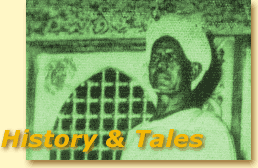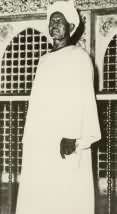

The Burhaniya Disuqiya Shadhuliya is the sufi order (tariqa) of Sayyidi Ibrahim Qurashi Disuqi (13th Century A.D.), the forth of the great sufi sheikhs and founders of sufi orders (aqtab). In the spiritual line (silsila) of the Burhaniya sheikhs traces back to the Prophet Mohammed (s.). The most important chain links are:
Sayyidi al Shaikh Mohamed Ibrahim Mohamed Osman Sayyidi al Shaikh Ibrahim Mohamed Osman Sayyidi al Shaikh Mohamed Osman Abdu al Burhani Sayyidi Ahmad Arabi al Sharnubi Sayyidi Musa Abu al Umran Sayyidi Ibrahim al Qurashi al Disuqi Sayyidi Abul Hasan al Shazuli Sayyidi Abdu al Salam ibn Bashish Sayyiduna wa Maulana al Imam al Husain Sayyiduna wa Maulana al Imam al Ali
Ziyadatan fi Scharaf al Mustafa, salla'llahu alaihi wa sallam
The name of our tariqa relates to
Burhan - the name of Sayyidi Ibrahim in the Hadra meditation [Photo] [Sound / 225 Kb]
Disuq - the town of Sayyidi Ibrahim in the north of Egypt
Shadhuli - Sayyidi Ibrahim's uncle Sayyidi Abul Hasan al Shazuli
The Tariqa Burhaniya has spread out in the time of Sayyidi Fahruddin Sheikh Mohamed Osman Abduh al Burhani († 1983) [Foto] and his son Sayyidi Sheikh Ibrahim Sheikh Mohamed Osman († 2003) [Photo]. Today, under the leadership of Sheikh Mohamed Sheikh Ibrahim Sheikh Mohamed Osman, there are many thousand followers and hundreds of Burhani communities all over the world [World of Burhaniya].
The spreading of Tariqa Burhaniya in the last decades is grounded in a rich heritage. This section is giving some accounts of the Burhaniya history.

Sheikh Mohamed Osman Abduh al Burhani was born in Halfa in Sudan at the turn of the century. At the age of 10 his uncle initiated him into the order of Burhaniya after Mohamed Osman had plead for it for a long time. But he could find no teacher in the outside world which meant he could perform no spiritual excercises nor receive any instruction. He held long nightly vigils in prayer during which he had visions wherein he was visited by some of the great saints. During these visions and in his dreams he learned some parts of the awrad - the special prayers of the Burhaniya. After many years had passed, he finally found a teacher, a blind stranger who had been sent to him by Sayyidi Ibrahim Disuqi, the original founder of the order. He later discovered books which had been buried in pots by his grandparents during the period of Mahdi in which many books were burnt. They enclosed the entire awrad of his Tariqa which Mohamed Osman immediately put to use for his followers. In a long vision taking over forty days he learned that his task was to revitalize the order of Sayyidi Ibrahim Desuqi. For two months, Mohamed Osman refused to take on this task until Imam al Hussein personally ordered him to do so. Under the leadership of Sheikh Mohamed Osman, Tariqa Burhaniya gained many followers in Sudan and in Egypt. During the seventies the order already counted over 3 million members alone in Egypt. Since 1981 the order has also spread to Europe and North America. Sheikh Mohamed Osman, who received the name Sayyidi Fahruddin, died on April 5th, 1983, and is buried in Khartum (Sudan). His grave (maqam) [Photo] has become a place of pilgrimage, and each anniversary thousands of Burhanis from all over ther world as well as members of other sufi orders gather to celebrate a great festival (hawliya) in his honour.

"During sleep and during my visions I saw a locomotive with only one wagon coming towards me and stopping right in front of my feet. I discovered that the train came from Disuq, the home of my Sheikh. This dream repeated itself for forty days. After that the vision became more tangible and I could enter it. I opened the wagon and found a coffin inside. I opened the coffin and found a corpse wrapped in white cloth. I lifted the white cloth and found a green cloth underneath. I lifted the green cloth and found a yellow cloth beneath it."
These are the three colors of the Tariqa: the white color is the one which the Messenger of Allah, the Prophet Mohammed (s), had given to Sayyidi Ibrahim. It symbolizes the Islamic law - the Sharia. The color green stands for Sayyidina Hussain and the color yellow for Sayyidi Abul Hasan al Shadhuli. Yellow symbolizes the conquest of the seven egos progressing upon the path.
After he had lifted all three cloths, Mawlana Sheikh Mohamed Osman saw the feet of the corpse and he was highly astonished to discover that they resembled his own. Then he discovered the prescence of the sheikh Sayyidi Abul Hasan al Shadhuli and many other saints. "Who is this deceased?" he asked. "It is Ibrahim Disuqi", was the answer. Mawlana broke into tears believing that all his efforts and many prayers had been in vain since his Sheikh had really died. But then Sidi Ibrahim Disuqi appeared to him in person. "The dead man stands for my Tariqa", he said, "and you have been chosen to bring it back to life". Mawlana refused to take on this task for two months. Then the saints appeared to him once more, this time in the company of Sayyidina Husain. It is said that one cannot refuse a request from him. He said, "My son, do not hesitate. Those who receive a burden, also receive support. Shoulder this responsibility and ask for whatever you need. It will be granted you. "Mohamed Osman posed many conditions, including the condition that his followers are not allowed to go mad (majzûb) and that they need not perform the spiritual retreat (khalwa). Sayyidi Ibrahim and Sayyidina Husain signed a contract including 60 conditions. This contract is still in the possession of the Sheikh of the Tariqa, Mawlana Sheikh Mohamed Sheikh Ibrahim Mohamed Osman.

As a child Mawlana Sheikh Mohamed Osman had a dream in which the great saint Sayyidi Ahmad al Badawi took him by the hand and led him to the mountain of the saints (jabal awliya), a place near Kartoum. He struck the mountain enforcing it to form a cave. "Pray in this cave" he ordered Mohamed Osman. The boy awoke and was puzzled by these instructions. He inquired into the mayor of that place, a man named Wasim, about the mountain. Wasim told him that the mountain was called Djabal Awliya since some saints had once prayed in one of its caves. Mohamed Osman finally found the place revealed in the dream - a cave, the floor of which was covered with white sand and in which the direction of prayer (qibla) was indicated. There he prayed for the Sheikhs of his order, their chain being only incompletely known to him. He returned to the cave in later years and spent six months there in spiritual retreat.

Even though Mawlana Sheikh Mohamed Osman had taken the covenant of the Tariqa Burhaniya many years before, he could still find no teacher or anyone else who could instruct him in the exercises needed to progress on the path of Allah. So he spent most of his time in the mosque where he studied Islamic law and Sharia. One day a blind Egyptian entered the room and asked him, "Don't you want to offer me a seat?" "This is a mosque", Mawlana answered, "Everyone is welcome here." The stranger turned and prayed as is custom when entering a mosque. Then he said, "Sayyidi Ibrahim Disuqi has sent me to teach you awrad." He stayed with Mohamed Osman for seven months and taught him all the details of awrad and other special exercises of the Burhaniya. In this time Mohamed Osman often secretly prayed for his teacher to be cured of his blindness. But then one day his teacher moved about the room, naming the color of every object - for although he was blind, he could see without using his eyes. After the seven months were over he left Mohamed Osman to return, as he said, to Disuq near the grave of Sayyidi Ibrahim Disuqi, which was his home. The next time Mohamed Osman was in Disuq he asked the people there about the stranger but nobody had ever heard of him.